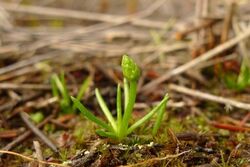Biology:Phylloglossum
| Phylloglossum | |
|---|---|

| |
| Scientific classification | |
| Kingdom: | Plantae |
| Clade: | Tracheophytes |
| Clade: | Lycophytes |
| Class: | Lycopodiopsida |
| Order: | Lycopodiales |
| Family: | Lycopodiaceae |
| Subfamily: | Huperzioideae |
| Genus: | Phylloglossum Kunze 1843 |
| Species: | P. drummondii
|
| Binomial name | |
| Phylloglossum drummondii Kunze 1843
| |
| Synonyms[1] | |
| |
Phylloglossum, a genus in the clubmoss family Lycopodiaceae, is a small plant superficially resembling a tiny grass plant, growing with a rosette of slender leaves 2–5 cm long from an underground bulb-like root. It has a single central stem up to 5 cm tall bearing a spore-producing cone at the apex, and was previously classified variously in the family Lycopodiaceae or in its own family the Phylloglossaceae, but recent genetic evidence demonstrates it is most closely related to the genus Huperzia and is a sister clade to the genus Phlegmariurus, which was formerly included in Huperzia.
Morphological characters, as well as molecular characters based on rbcL data, support the close relationship of Phylloglossum to Huperzia. Similarities in spore morphology, sporangial epidermis morphology, phytochemistry, and chromosome number indicate that Phylloglossum and Huperzia are closely related.[2]
A morphological character that complicates this is the presence of a perenniating tuber in Phylloglossum, which has, in the past, misled scientists to place it more closely to the genus Lycopodiella. Phylloglossum is unique within Lycopodiaceae due to this perenniating tuber, which is a reduced stem system that has developed to be considered a new organ.[2]
Its gametophyte is non-photosynthetic at first, getting its nutrients from mycorrhiza, but develops a photosynthetic crown as it matures.[3]
The only species, Phylloglossum drummondii (pygmy clubmoss), is a native of Australia (southwestern Western Australia, southern South Australia, Victoria and Tasmania) and New Zealand (North Island).
References
- ↑ Hassler, Michael (19 January 2023), "Phylloglossum", World Ferns. Synonymic Checklist and Distribution of Ferns and Lycophytes of the World, 14.7
- ↑ Jump up to: 2.0 2.1 Wikström, Niklas (July 2001). "Diversification and Relationships of Extant Homosporous Lycopods". American Fern Journal 91 (3): 150–65. doi:10.1640/0002-8444(2001)091[0150:daroeh2.0.co;2]. https://www.biodiversitylibrary.org/part/230742.
- ↑ Observations on the mature gametophyte of Phylloglossum (Lycopodiaceae)
- Wikstrom, N. and P. Kenrick (1997). "Phylogeny of Lycopodiaceae (Lycopsida) and the relationships of Phylloglossum drummondii Kunze based on rbcL sequences". International Journal of Plant Sciences 158 (6): 862–871. doi:10.1086/297501.
External links
- "Phylloglossum drummondii". NZ Plants. University of Auckland. http://www.nzplants.auckland.ac.nz/en/about/lycophytes/lycopodiaceae-clubmoss-fir-moss/phylloglossum.html. Retrieved April 30, 2021.
- "Photo". Australian National Botanical Gardens. https://www.anbg.gov.au/photo/apii/id/p/274. Retrieved April 30, 2021.
Gallery
Six-leaved plant with two roots, the full length of one of which is shown in its natural position. The very numerous root hairs are merely indicated diagrammatically as are the hairs on the new tuber
Wikidata ☰ Q4993437 entry
 |



